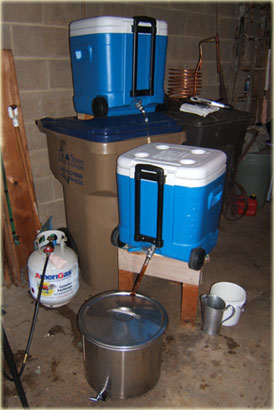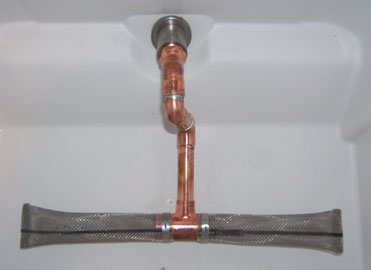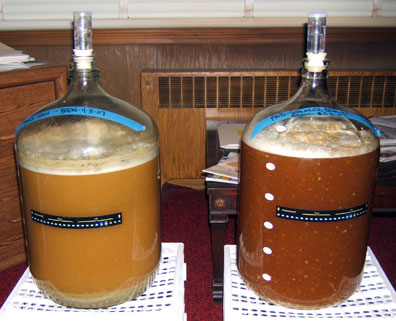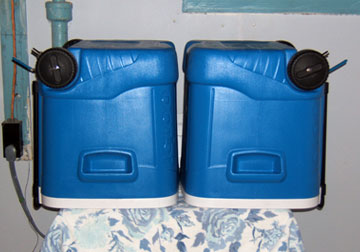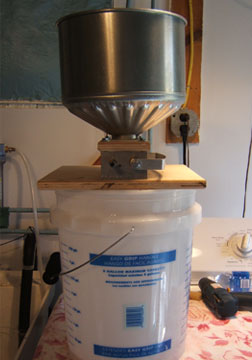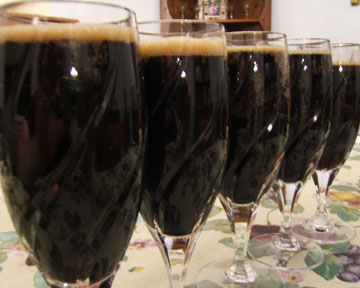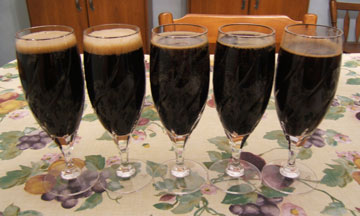Hazelnut Brown
Tuesday, April 17th, 2007On Sunday I brewed a beer that will hopefully turn out similar to Rogue’s Hazelnut Brown Nectar. It should be a cross between a mellow American Brown ale and a Robust Porter, leaning to the brown side, with a definitive hazelnut flair.
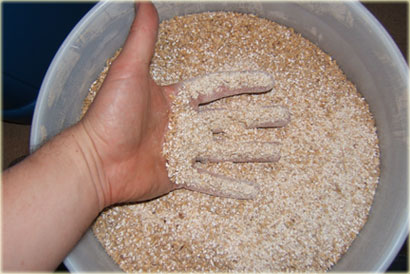
I had somehow printed but not saved the recipe in ProMash, the brewing recipe program I used. So, I had to retype in the recipe – and again I forgot to save, so again I retyped it in. This made me feel very stoopid. Then I got to play with my new grain mill again, so far it is still fun. Karen was interested to see it in action, so I let her weigh all the grains and load the hopper. Unfortunately, right when she was getting ready to grind she got a long distance phone call. With the big storm here, I had to relocate my typical brew spot. So, I hauled everything up from the basement and brewed in the garage with the door wide open for proper ventilation. It was cool to brew in there, but it was a pain in the balls hauling everything up, and running up and down when ever I realized I forgot something. I added a small second burner to my set up now too. I don’t need it for anything, but it’s useful to have available if I wanted to sterilize something with boiling water (like my oxygen stone) or to pull some wort and boil it down to add some extra character.
Right before the end of the mash and while my sparge water was still heating I ran out of propane! This is the second time this has ever happen to me. After the first time, I bought a back-up tank, but this time the back-up was empty too. So, I put everything on hold and made a propane run which wound up taking a good 45 minutes. Buy the time I got back the water temperatures had dropped, but not as bad as I had thought. So, after everything was set, I mashed-out, recirculated, and began my sparge which went OK until the last little bit. Basically I have a crappy pick-up tube on the inside of the HLT. Again, since the valve comes in at a 45 degree angle, something has to be used to connect the valve to the bottom. In the mash tun I have the copper Bazooka-T, in the HLT I have a piece of reinforced plastic tube. Well, the problem is when the tube is heated by the 175 degree sparge water it softens and begins to loosen around the connector to the valve. No problem I thought, I’ll put a hose clamp around it. Well the OD on the hose is like 5/8th and I didn’t have a hose clamp big enough, so I tried using what I had available – a zip tie. It didn’t work. It wasn’t that big of a deal, I just stood there and tipped the HLT, problem solved, but not permanently.
After the sparge was through everything on the boil side seemed to go fine, nothing that I can really remember standing out. Again, Karen came out and chilled which is always nice. When it was time to cool I was worried that my “brew hoses” weren’t going to be able to reach the garden spigot, but they did, so no problems there. I had to do a little rearranging in the fermentation room (computer room) to make sure there was room, so I took PA3 which had finished fermenting down to the bottling area (laundry room), which is different than the secondary fermentation area (chamber number two). When the brew day (minus cleaning up) was done, I stopped for about an hour for a break and to eat some dinner Karen made. After clean up it was somehow like 10PM. My OG was much higher than anticipated, up in the range of almost 90% efficiency Hopefully this will hold true for the new mashing equipment, which would mean I could use less ingredients to gain the same results, thus saving money. So between retyping the recipe twice, playing solder boy with the copper piping, hauling all my crap around, brewing, making a propane run, finish brewing, moving carboys, eating, and cleaning up it turned out to be almost a 12 hour day! Don’t know how that happened, but I was wooped. Plus the fact that Sunday was day 7 of being sick (today is day 9) didn’t help much either.
 So next up on the brew schedule are two wheaty beers, so this should be interesting. I am planning on brewing a Witbier and a Saison, which I have never brewed the later. Both styles are quite refreshing so that’ll be nice going into the warmer time of the year. Then hopefully something big and stinky to lay down for winter: a Russian Imperial Stout, or Old Ale.
